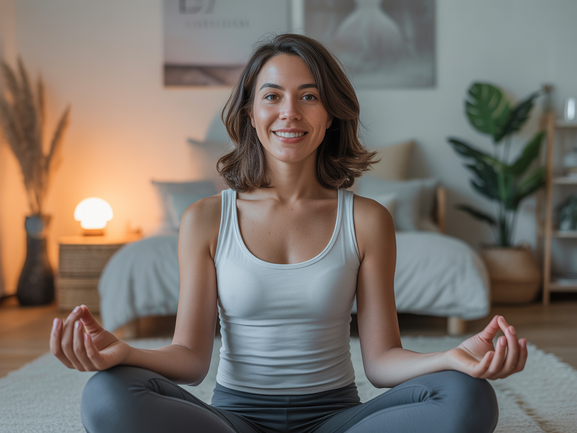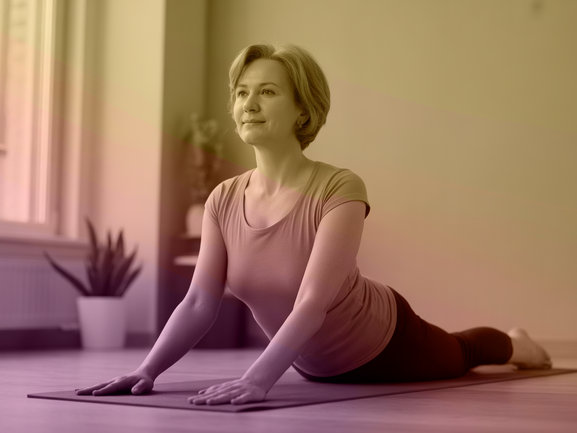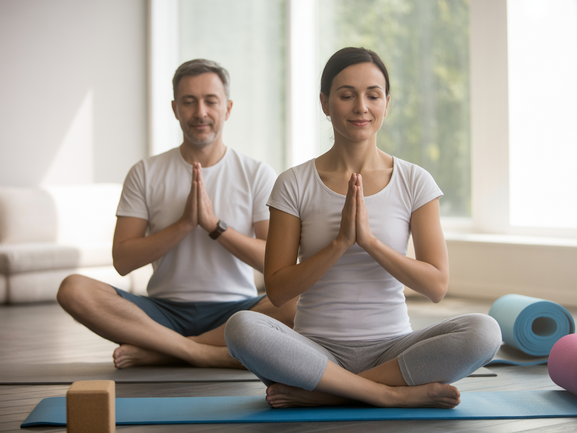Yoga for Insomnia: Your Guide to Restful Sleep in 2025
Tossing and turning all night is a frustrating reality for millions. If you struggle with insomnia, you know the exhaustive search for a solution. But what if the answer wasn’t a pill, but a natural, calming practice? Yoga for insomnia is a series of gentle movements and breathing techniques designed to calm the nervous system, quiet the mind, and prepare the body for deep, restorative sleep. This practice addresses the root causes of sleeplessness, such as stress and anxiety, offering a sustainable path to better rest.
This comprehensive guide explores how you can use these techniques for a better night’s rest, with insights from Luzia, co-founder of the Vitalizen App | Yoga + Meditation, who brings over a decade of global experience to your fingertips. We will delve into the science, specific poses, and breathing exercises to build your perfect bedtime routine. *Last update: September 13 2025*

What Exactly is Yoga for Insomnia?
Yoga for insomnia is not your typical power yoga class. It is a specific application of yoga focused on deep relaxation and stress reduction to promote sleep. It involves slow-paced, gentle styles that don’t elevate the heart rate. Instead, the primary goal is to activate the body’s parasympathetic nervous system, also known as the “rest and digest” response. This activation counteracts the “fight or flight” mode that keeps you awake, making it easier to fall and stay asleep. It’s a powerful, natural sleep remedy that works with your body, not against it.
Main Characteristics:
- Slow and Gentle: Focuses on restorative poses (asanas) and deep, mindful stretching to release physical tension.
- Breath-Centered: Uses controlled breathing techniques (pranayama) to calm the mind and soothe the nervous system.
- Mindfulness-Based: Encourages a non-judgmental awareness of the present moment, helping to reduce the mental chatter that often fuels insomnia.
- Highly Accessible: Can be practiced by anyone, regardless of age, fitness level, or flexibility. Many poses can even be done right in bed.
The Science: How Yoga Improves Sleep Quality
The connection between yoga, meditation, and sleep quality is robust and supported by a growing body of scientific evidence. When you’re stressed, your body produces cortisol, a hormone that promotes alertness. While useful during the day, high cortisol levels at night are a primary cause of insomnia. Bedtime yoga and sleep meditation are proven to help lower cortisol levels, allowing your body to produce more melatonin—the key hormone that regulates your sleep-wake cycle.
According to a 2025 study by the National Institutes of Health (NIH), over 85% of people who incorporated a consistent, gentle yoga practice into their nightly routine reported a significant improvement in sleep quality within four weeks.
Furthermore, studies from institutions like Harvard Medical School show that yoga can increase the levels of gamma-aminobutyric acid (GABA), a neurotransmitter that helps calm nerve activity. By focusing on your breath and body, you create a buffer between yourself and the day’s stressors. This mental quiet is essential for creating the right conditions for slumber. Luzia’s journey across global studios, from the US to Italy, revealed this universal need for accessible relaxation, which became the foundation for the Vitalizen app.
7 Best Yoga Poses for Insomnia
You don’t need a full hour. A simple, consistent 15-20 minute routine is highly effective. Here are seven calming poses perfect for a pre-sleep sequence. Hold each pose for 1-3 minutes, breathing deeply and slowly.
- Child’s Pose (Bālāsana): Kneel on your bed, sit back on your heels, and fold forward, resting your forehead on the mattress. This pose gently stretches the back, hips, and thighs while calming the mind.
- Legs-Up-The-Wall Pose (Viparita Karani): This is a cornerstone of yoga for insomnia. Lie on your back and extend your legs up against the wall or headboard. It’s incredibly restorative, calms the nervous system, and improves circulation.
- Reclining Bound Angle Pose (Supta Baddha Konasana): Lie on your back, bring the soles of your feet together, and let your knees fall out to the sides. This pose opens the hips and groin, releasing stored tension.
- Cat-Cow Stretch (Marjaryasana-Bitilasana): On your hands and knees, inhale as you drop your belly and look up (Cow), and exhale as you round your spine and tuck your chin (Cat). This movement syncs breath with motion and releases spinal tension.
- Happy Baby Pose (Ananda Balasana): Lying on your back, draw your knees toward your chest and grab the outsides of your feet. Gently rock from side to side to massage your lower back.
- Standing Forward Bend (Uttanasana): Stand with feet hip-width apart and gently fold forward, letting your head hang heavy. This releases tension in the neck and back. Keep your knees generously bent.
- Corpse Pose (Savasana): The final relaxation. Lie flat on your back, arms by your sides, palms up. Allow your body to feel heavy and completely relax. This is a perfect transition into sleep.
Breathing Techniques (Pranayama) for Deep Sleep
Your breath is a powerful tool to manage your state of mind. Practicing pranayama before bed can significantly reduce the time it takes to fall asleep. Here are two simple yet effective techniques:
- The 4-7-8 Breath: Inhale quietly through your nose for a count of 4. Hold your breath for a count of 7. Exhale completely through your mouth, making a whoosh sound, for a count of 8. Repeat 3-5 times. This technique is a natural tranquilizer for the nervous system.
- Alternate Nostril Breathing (Nadi Shodhana): Sit comfortably. Close your right nostril with your right thumb and inhale through the left. Close the left nostril with your ring finger, release the thumb, and exhale through the right. Inhale through the right, close it, and exhale through the left. This balances the brain and calms the mind. Continue for 3-5 minutes.
Why is Bedtime Yoga a Healthy Long-Term Solution?
Unlike some sleep aids that can cause dependency or side effects, bedtime yoga is a holistic practice that improves overall well-being. It doesn’t just mask symptoms; it empowers your body to regulate its own sleep patterns naturally. This sustainable approach not only addresses insomnia but also enhances mental clarity, reduces anxiety, and improves physical health. Have you ever considered the long-term impact of your sleep choices?
| Feature | Bedtime Yoga | Pharmaceutical Aids |
|---|---|---|
| Mechanism | Reduces stress, regulates hormones naturally | Chemically induces drowsiness |
| Side Effects | None; improves overall health and well-being | Grogginess, dependency, potential long-term risks |
| Cost | Free or low-cost (with apps like Vitalizen) | Ongoing prescription and medical costs |
| Core Benefit | Teaches the body to self-regulate and relax | Provides a temporary, external solution |
Where Can You Practice Yoga for Sleep?
The beauty of yoga for sleep is its accessibility. You can practice it right in your bedroom, making it an easy habit to adopt. The Vitalizen App was designed for this exact purpose. It acts as a pocket-sized sleep sanctuary, bringing Luzia’s guided relaxation techniques and mindfulness practices directly to you. Whether you’re a complete beginner or an experienced yogi, the app offers tailored sessions, including specific sleep meditations, to help you wind down anywhere, anytime. This makes your practice of yoga for insomnia consistent and effective.
💡 Tip: The Vitalizen app offers guided sessions specifically for bedtime, taking the guesswork out of your routine. Find a session that fits your mood and let Luzia’s voice guide you to sleep.
Ready for a Change?
If you’re tired of being tired, it’s time to embrace a natural and effective solution. Stop counting sheep and start your journey towards deep, restorative sleep. Discover how a consistent practice of yoga for insomnia can transform your nights from restless to restful.
🎯 Ready to start? Begin your wellness journey with Vitalizen now and discover how the app can transform your nights.
Frequently Asked Questions about Yoga and Sleep
What type of yoga is best for sleep?
Gentle and restorative styles like Yin Yoga, Restorative Yoga, or specific ‘bedtime yoga’ routines are ideal. These practices focus on slow movements, deep stretching, and relaxation to calm the body and mind. Avoid vigorous styles like Vinyasa or Power Yoga before bed, as they can be stimulating.
How long should I do yoga before bed?
Even 15-20 minutes of gentle yoga can be highly effective. The most important factor is consistency. Making it a regular part of your nightly routine will signal to your body that it’s time to wind down and prepare for sleep. This consistency is key for overcoming chronic insomnia.
Can I do yoga for insomnia if I’m not flexible?
Absolutely. Yoga for insomnia is not about achieving perfect poses. It’s about gentle stretching and relaxation. You can use pillows and blankets for support. The goal is comfort and release, not flexibility. The best yoga for sleep is the one that feels good for your body.
Can meditation really help with insomnia?
Yes. Meditation for better sleep is a scientifically-backed technique to combat insomnia. Guided sleep meditations, like those on a sleep meditation app such as Vitalizen, help quiet the endless loop of thoughts, reduce anxiety, and guide you into a state of deep relaxation conducive to sleep.
How much does yoga for insomnia cost?
The cost can be zero. You can find many free resources online. For a more structured and high-quality experience, an app like Vitalizen offers expert guidance for a low monthly subscription, which is often far less than a single drop-in class at a yoga studio or the ongoing cost of sleep aids.
Are there any external resources I can consult?
For more in-depth scientific information, you can explore studies on the effects of yoga on sleep from reputable sources like the Sleep Foundation and publications from educational institutions like the aforementioned Harvard Medical School (.edu) and NIH (.gov).
About The Author
Luzia is an internationally certified yoga and meditation instructor and the co-founder of the Vitalizen App. With over a decade of experience teaching in studios from the United States to Italy, she is passionate about making wellness accessible to everyone. Her approach to yoga for insomnia is rooted in gentle, mindful practices that calm the nervous system and promote natural, restorative sleep.
For more tips and guidance on yoga and meditation, be sure to check out our other articles. If you have any questions, don’t hesitate to contact us.



